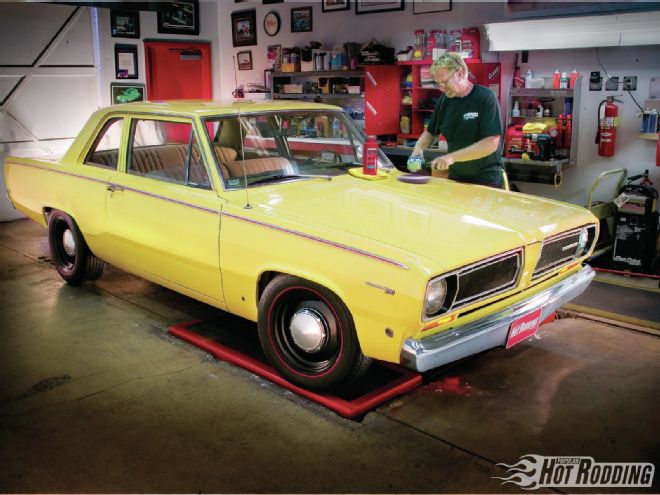
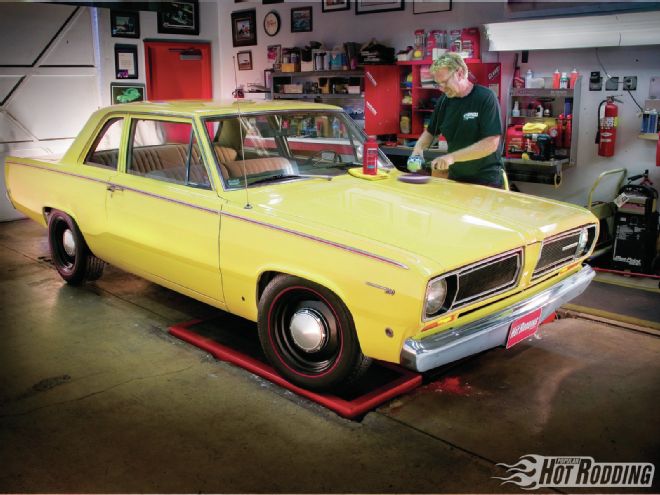
Those Occupy Wall Street folks just might be onto something. The 1 percenters have all the fun while the rest of us get nada. The hot rodding world certainly has its equivalent. The 1 percenters build sky-is-the-limit checkbook cars, while the rest of us window shop eBay and Craigslist. Sigh. Maybe one day. Screw that! Don’t stand around in some imaginary car guy unemployment line—we say, occupy Goodguys! Occupy Super Chevy! Occupy the Car Craft Summer Nats! Why should check writers have all the fun?
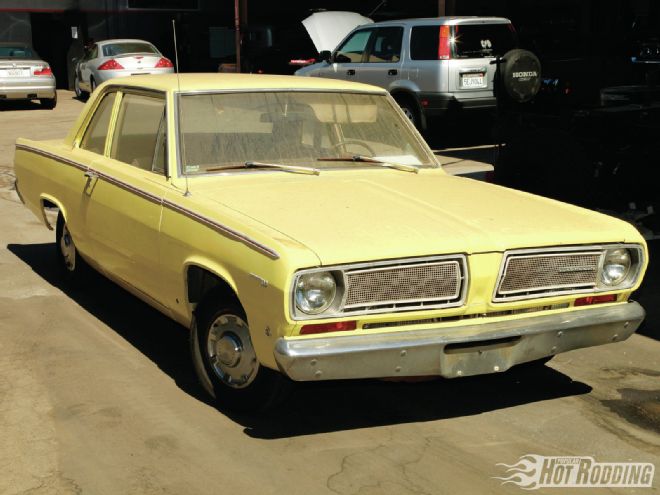 Up front, we knew we wanted something classic, something affordable, and something two-door. Most hardtops were out of our price range, but this ’68 Plymouth Valiant post car was perfect. We wanted something rust-free under $3K; it took three months of looking through Craigslist ads, but we scored this Slant Six automatic Mopar for just $2,500. The deals are out there—you just have to be patient! In this state, it’s still far from being cruise-in or car-show ready though …
Up front, we knew we wanted something classic, something affordable, and something two-door. Most hardtops were out of our price range, but this ’68 Plymouth Valiant post car was perfect. We wanted something rust-free under $3K; it took three months of looking through Craigslist ads, but we scored this Slant Six automatic Mopar for just $2,500. The deals are out there—you just have to be patient! In this state, it’s still far from being cruise-in or car-show ready though …
We decided to do something about it. We figured the best way to get the fence sitters out of the car guy unemployment line and into the cruisin’ lane was to prove that you can get into the game and be a real player for small bank. We spent real money on a real car and real parts—and you would be astonished to know what kinds of cool comments we’ve gotten on our ’68 Valiant since we pulled off this fantastic feat.
The Car
One tip to duplicating our low price of admission is that we started out with a long list of possible car candidates. Had we actually been looking for a ’68 Valiant, we surely would’ve paid more, but we were open to any car—the only “must haves” were that it needed to be locally owned, domestic, two-door, no convertible, no rust, driveable condition, mostly straight body, and ’60-72 model year. We searched for three months, looked physically at a dozen cars, and cherry picked the best deal when it came up. Three strategies saved us from overspending on project car fodder: we weren’t obsessed with finding a specific car model, we weren’t hell-bent on a V-8, and we placed fanatical importance on a straight, rust-free body with salvageable paint. That last one may seem like a costly concession, but it actually saves a bucket of money on body and paint. Framing those principles was the knowledge that a killer-looking wheel/tire package and the right stance can make practically any car look good.
When searching for a car, time is on your side—despite pressure from sellers telling you otherwise. That cash may be burning a hole in your pocket, but resist the urge to buy rust in the shape of a car. Can’t find anything nice at your price? The longer you take to add to the spending pot, the larger your cash kitty will grow, and the nicer your project can be. We started out with a $1,700 pot, but by the time we found our Valiant three months later, we had $2,500 stashed.
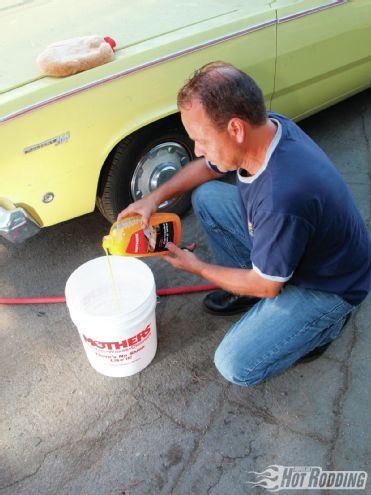 Our Valiant had been sitting in the desert, buried up to its axles in sand for 30 years, so saying it was covered in crap is an understatement. To even see what we had paint-wise to work with, we needed to give it a bath. We started with some Mothers California Gold Car Wash. Day one of our weekend resto was spent with the Mopar lovers at Picture Car Warehouse—PCW’s Al Kruger is shown giving us a hand.
Our Valiant had been sitting in the desert, buried up to its axles in sand for 30 years, so saying it was covered in crap is an understatement. To even see what we had paint-wise to work with, we needed to give it a bath. We started with some Mothers California Gold Car Wash. Day one of our weekend resto was spent with the Mopar lovers at Picture Car Warehouse—PCW’s Al Kruger is shown giving us a hand.
Patience and responsible buying habits do pay off. We found a remarkably nice Slant Six ’68 Plymouth Valiant for $2,800 and talked the seller down to $2,500. To the good, it was virtually rust free, it was a running car with no major mechanical issues, the interior was surprisingly well preserved, the paint was all there, and the body was mostly straight. On the negative side, there are numerous electrical issues, it’s a Slant Six, and there is some slight road rash on the front left fender. We figured those negatives would be easily worked out over time, as long as we could drive it over the short term. As for the parking lot scrapes on the front left fender—they’re small enough that they serve to add charm. At least paint still covers them and they are darned hard to see in photos.
The Game Plan
Some gearheads might put the first priority on building a nasty motor with a snotty attitude. We’ve done that before, in fact it’s our normal mode of operation. Lay rubber first, worry about what it looks like later. Since we have the luxury of other cars that already pound the pavement with big cubes and massive pound-feet, we thought starting with the looks could be cool for a change. Buy the car, do a quick rehab, and get into the cruisin’ lane ASAP. When cash is thin, you don’t want to have to keep laying out Benjamins month after month, year after year, with no seat time in return. Our plan: have fun with the mon.
Part two of the plan was reliant on how successful we were with part one. We’ve done enough body and paint special issues to know that we wanted to bypass that huge time suck and start the love rubbing. Big rust or body damage was a no-go, but older oxidized paint, we figured, could be brought back to life. When we saw the chalky single-stage paint on the Valiant, we were pretty sure we could bring it back from the dead. When we found evidence it had been repainted a long time ago the same color as the factory paint, we knew we had a lot of material on the car to work with. Bingo! We could bypass sanding, prepping, primering, and painting, and essentially go straight to the final cut and polish.
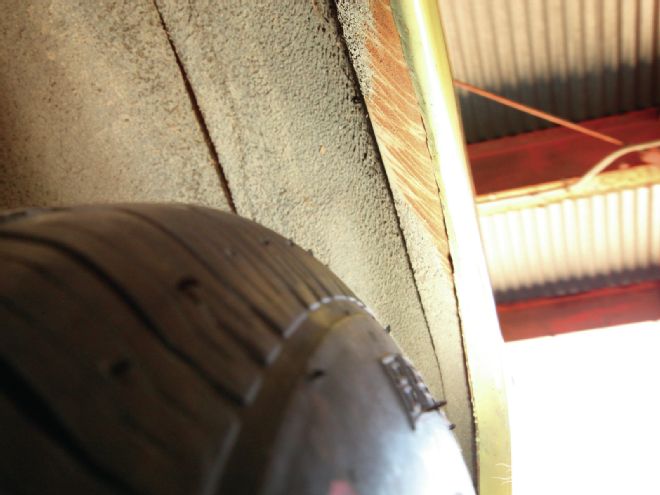 Up on the lift, you can see the rear wheelhouse where Dulcich and Kruger rolled the fender lip. The inner wheelhouse has yet to be clearanced in this photo. You can see the witness marks where the tire has smeared the inner housing when the car was lowered down to the ground.
Up on the lift, you can see the rear wheelhouse where Dulcich and Kruger rolled the fender lip. The inner wheelhouse has yet to be clearanced in this photo. You can see the witness marks where the tire has smeared the inner housing when the car was lowered down to the ground.
We’d seen enough badass Mopar A-Bodies to know our Valiant was just a wheel/tire swap and torsion bar adjustment away from a killer rake. Over the years, we’d formed an opinion about how we might address a Mopar A-Body if we had the chance to nab one. And while it’s been proven that A-Bodies make great Pro Touring cars, we wanted something that hearkened back to a simpler era. After all, these are uncomplicated cars. It’s not supposed to look like a radar-guided cruise missile, it’s granny getting groceries with a concealed carry permit. In our mind, there was never any question about rolling stock—Coker Tire in Chattanooga, Tennessee, was already on speed dial, and satin-black 15-inch steelies with redlines is what we craved.
Most importantly, we wanted to get everything done fast. Deadline pressure notwithstanding, hot rodders don’t like waiting around. Like everything in the now generation, it’s all about instant gratification. We could draw this out over months or years, but why wait when we can deliver the punch line right now? We decided to do our Valiant’s restoration in just 48 hours. Some of the stuff, like the interior, powertrain, brakes, and suspension would just have to wait. We just want to get rolling in style as quick as possible, so let’s get it on!
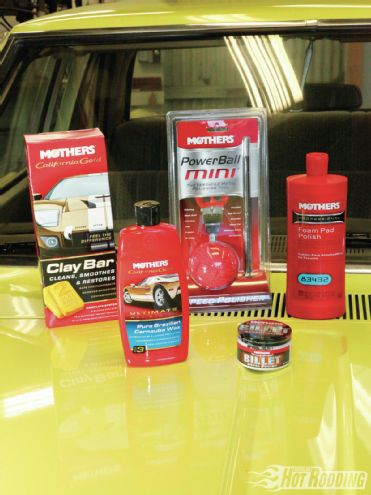 Up front, we are taking advantage of Mopar’s torsion bar suspension. Lowering the front of a car for better stance normally means cutting the coil springs—but this isn’t a Ford or a GM. PCW Mopar expert Kruger took one look at the Valiant with the new Coker redlines on, rubbed his chin, and declared that six full loosening turns (CCW) of the torque arm screw would yield the perfect stance. He was dead on.
Up front, we are taking advantage of Mopar’s torsion bar suspension. Lowering the front of a car for better stance normally means cutting the coil springs—but this isn’t a Ford or a GM. PCW Mopar expert Kruger took one look at the Valiant with the new Coker redlines on, rubbed his chin, and declared that six full loosening turns (CCW) of the torque arm screw would yield the perfect stance. He was dead on.
The Stance
The wheels and tires make or break the look of any hot rod. You’ve gotta get the right rolling stock, they have to fill the wheelwells right, they can’t stick out, they can’t be too buried in the wheelwell, the front can’t be too high or too low, and the back can’t look too high or too low. All too often, guys just buy the wheels and tires without researching, then throw ’em on, and crack a beer. News flash: Unless you just get lucky, that procedure looks like crap. For criminy sakes, if you’re going to spend real coin on wheels, at least make ’em look right?
Fortunately, with a Mopar we got to dispense with the sometimes risky guesswork of cutting coil springs. All Mopars have an adjustable torque arm front suspension, which means you can crank one bolt on each front lower control arm and lower or raise the suspension. GM and Ford guys would kill for something like this. Considering how cool and easy that is, we’re absolutely mystified that more Mopars don’t sport a killer stance. Who knows, maybe they’re going for that high-floodwater-comin’ look.
Moving along, we researched our wheel and tire sizes on the Moparts.org and ForABodiesOnly.com forums before buying wheels and tires. If you’re already into Mopars or just getting into them, let’s face it, there is no better place to go for your online A-Body tech fix. But be forewarned, if you post on their forum, the Moparts.org people will not cut you any slack if you’re a dumbass—they’re in your face, and they’re deadpan honest. Don’t go snooping around there with no Chevy—that’s as bad as picante sauce from New York City. ForABodiesOnly.com is a little more family friendly, and they’ve actually got a specific section devoted to A-Body wheels and tires. We gathered enough good info from both forums to inform our selection of 15x8 Coker steelies in the rear, and 15x6 Coker steelies in front. (Unless you go custom offsets, there is no choice in backspacing, and only the larger 5x4.5-inch bolt pattern is available.) We also gathered tire size data, paying particular attention to the larger sizes that were being used successfully with stock wheelwells, and chose 225/60R15s for the rear and 215/65R15s for the front—both in Coker’s beautifully reproduced BFG Silvertown redline radial. All together, our Coker rolling stock (tires, rims, hubcaps) set us back $1,592. We do suggest one thing, however, when placing an order with Coker: Some items aren’t always on the website—like our O.E. Mopar hubcaps ($55 each). We recommend you phone a Coker product specialist after browsing the website, that way you won’t miss anything.
 We would not have believed what transpired on day two of our weekend resto if we had not witnessed it ourselves. We drove the Valiant to Classy Cars Auto Detailing in Huntington Beach, California, where proprietor Jeff Jeppesen showed us the optimal way to use this magical grouping of Mothers car care products. Let the magic begin …
We would not have believed what transpired on day two of our weekend resto if we had not witnessed it ourselves. We drove the Valiant to Classy Cars Auto Detailing in Huntington Beach, California, where proprietor Jeff Jeppesen showed us the optimal way to use this magical grouping of Mothers car care products. Let the magic begin …
Being a Slant Six, the Valiant sports the low-performance 5x4-inch bolt circle. Nobody makes cool wheels for this, so don’t even try looking. No worries though. We got the large bolt circle wheels and mounted them to the Valiant using Trans-Dapt hub adapters designed for the purpose. Be mindful that these aren’t high-performance parts—they’re designed for light to normal road use. Don’t plan on hitting the autocross, dragstrip, or road course with them, as the stock spindles and bearings will not be able to handle the extra shear load. They are, however, perfect for cruising, and that’s what we intend to do until we upgrade our spindles and axles.
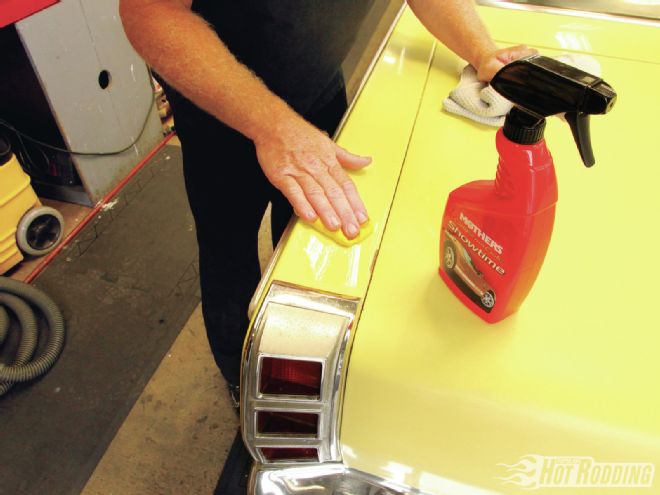 Our ’68 Valiant had an SS-1 paint code, telling us that our aging single-stage repaint was the original Sunfire Yellow. While there are a few dozen chips and minor surface rust spots peppering the Valiant, the repaint was deemed salvageable by Jeppesen. His first move was to use the Mothers Clay Bar System on it. After washing and drying the paint, spay a small section with the included Mothers Showtime Detailer (used as a lubricant), and rub the sprayed area with the clay bar. To finish, just wipe dry with a microfiber towel. The clay will remove embedded dirt and smooth the finish. Many cars will only need this process to look nearly new.
Our ’68 Valiant had an SS-1 paint code, telling us that our aging single-stage repaint was the original Sunfire Yellow. While there are a few dozen chips and minor surface rust spots peppering the Valiant, the repaint was deemed salvageable by Jeppesen. His first move was to use the Mothers Clay Bar System on it. After washing and drying the paint, spay a small section with the included Mothers Showtime Detailer (used as a lubricant), and rub the sprayed area with the clay bar. To finish, just wipe dry with a microfiber towel. The clay will remove embedded dirt and smooth the finish. Many cars will only need this process to look nearly new.
We got our rolling stock all together, and headed down to Picture Car Warehouse in Northridge, California, for our first day of rehab. We washed the grime off with Mothers California Gold Car Wash, mounted the spacers and Coker rolling stock, lowered the front ride height, addressed clearance issues with the fender lips and such, straightened some bent trim, and restored the grille with a Dupli-Color spray bomb.
Paint Rehab
Day two of our weekend resto was spent at Classy Cars Auto Detailing in Huntington Beach, California. You have two choices here: Use the techniques shown here by proprietor Jeff Jeppesen and burn your own elbow grease (in which case you’d only be out $95 or so for the Mothers car care products we used), or you can take your diamond in the rough to Classy Cars and let them work their paintless auto restoration magic while you take a stroll on the beach. (Easy there, Captain Check Writer.) Jeppesen quotes approximately $1,000 to do a job like ours, which may seem like a lot, but just know that he leaves no stone unturned—it will look nearly as good as a new paintjob when he’s done, or he won’t do it. What we particularly like is that before quoting a job, Jeppesen will test individual products and techniques in small areas of the paint to see what products are best and what results are possible. Unlike a paintjob, you actually get to see the end result before any of the work is done. Jeppesen is a big proponent of Mothers car care products because they flat-out work. When your livelihood depends on being able to work magic on a daily basis, the stuff in the bottle better deliver the results, or you’re out of business.
Of all the Mothers products outlined in our story, we were most impressed with Mothers Professional Foam Pad Polish, which before our unbelieving eyes transformed a chalky 30-year-old repaint into a crystal-clear shine. The key was using a high-speed buffer at 1,200 rpm with a waffle-shaped foam polishing pad. When preceded with the Mothers California Clay Bar system and followed up with an application of Mothers Pure Brazilian Carnauba Wax, our Valiant could walk the walk with pride at any car show or cruise in the land.
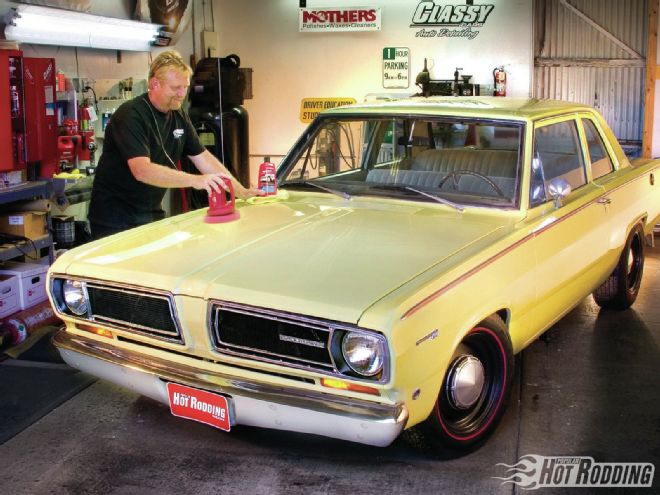 If we hadn’t spent an hour filling in a few minor chips with touch-up paint, we’d have sworn Classy Cars Auto Detailing had repainted the entire car—it looked that good. You can do everything Jeppesen did at home—the Mothers products we used totaled about $95—or drop the car with Jeppesen for the day and pay $1,000. Either way, you’ll freak out over the results.
If we hadn’t spent an hour filling in a few minor chips with touch-up paint, we’d have sworn Classy Cars Auto Detailing had repainted the entire car—it looked that good. You can do everything Jeppesen did at home—the Mothers products we used totaled about $95—or drop the car with Jeppesen for the day and pay $1,000. Either way, you’ll freak out over the results.
All together, we spent a total of $4,324.30 on the car, the Coker rolling stock, Trans-Dapt wheel hub adapters, Mothers detailing products, and Dupli-Color spray paint. What we now have is a cool-looking boulevard cruiser that turns heads and elicits comments wherever it goes. It’s not the fastest thing on the road with a Slant Six, but we are in the game and rolling chill for basically chump change. The cool thing is, you can do it too—we just gave you the road map. Don’t let the 1 percenters have all the fun—get out there and occupy Goodguys!
Win Cool Mothers Stuff!
Lucky for you, we videotaped the entire rehab process on the Valiant and edited it into a cool 11-minute video. See Editor Hunkins, Steve Dulcich, Picture Car Warehouse, and Classy Cars Auto Detailing all in one action-packed episode! Just log on to www.YouTube.com/PopularHotRodding and look for the video named “1968 Plymouth Valiant—Weekend Rehab.” The first person to watch the video and tell us what interesting thing we found in the Valiant’s engine compartment gets a nice selection of Mothers car care products! Just email John.Hunkins@sorc.com before October 12, 2012 with the winning answer and your mailing address!
What To Get Description: Source: PN: Cost: ’68 Plymouth Valiant Slant Six Craigslist.com NA $2,500 215/65R15 BFG redline radial reproduction Coker Tire 555750 $246 ea. 225/60R15 BFG redline radial reproduction Coker Tire 5797879 $228 ea. Mopar 15x6 steel wheel, 5x4.5-bolt pattern Coker Tire MPRST156P $106 ea. Mopar 15x8 steel wheel, 5x4.5-bolt pattern Coker Tire MPRST158P $106 ea. O.E. Mopar hubcap Coker Tire 2050 $55 ea. Wheel hub adapters, 5x4 hub to 5x4.5 wheel Trans-Dapt/Summit 7066 $61.95 pr. Mothers California Gold Car Wash Mothers/Summit 05600 $4.25 Mothers PowerBall Mini Mothers/Summit 05141 $21.00 Mothers California Clay Bar System Mothers/Summit 07240 $16.95 Mothers Pure Carnauba Wax Mothers/Summit 05750 $11.75 Mothers Billet Metal Polish Mothers/Summit 05106 $12.75 Mothers Professional Foam Pad Polish Mothers/Summit 83432 $27.95 Chrome spray paint Dupli-Color/Summit CS101 $6.50 Satin black trim paint Dupli-Color/Summit TP70 $7.25